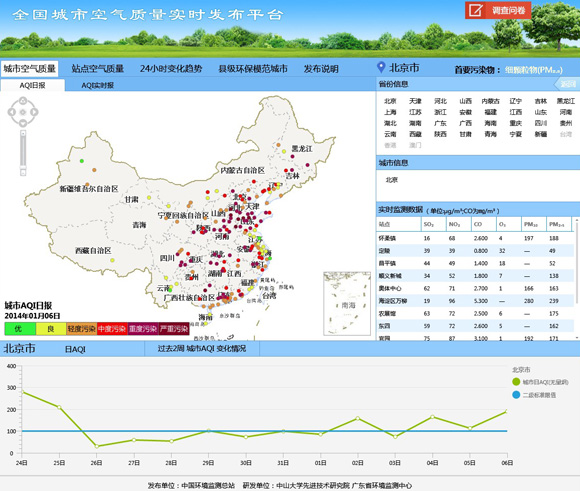The National Urban Air Quality Real-time Publishing Platform developed by SYSU successfully upgraded
Source: Institute of Advanced Technology
Written by: Institute of Advanced Technology
Edited by: Wang Dongmei
A real-time air quality reporting system Version 2.0 (referred to as “Air Reporting System”) developed by the Institute of Advanced Technology, the School of Engineering at Sun Yat-sen University and Guangdong Environmental Monitoring Center (GDEMC) has been in operation on the China National Environmental Monitoring Center (CNEMC) website since January 1st, 2014. According to the requirements of Ambient Air Quality Standard (GB3095-2012), the reporting system has been upgraded to undertake the second phase of the national air quality publishing tasks.
There are 116 cities, 449 monitoring sites increased in the reporting system Version 2.0. So far, it has been covering 190 cities, 945 monitoring sites. A largest-ever real-time air quality monitoring network of China is built, implementing the full coverage of municipalities, provincial capitals, cities with independent planning, all prefecture-level cities of "three zones" (Beijing-Tianjin-Hebei region, Yangtze River Delta and Pearl River Delta area), key environmental protection cities and environmental protection model cities. Moreover, some new contents have been added to the reporting system, such as urban air quality AQI daily report and real-time report, historical trends of contaminants for 24 hours with all the monitoring sites, the city AQI changes in the past two weeks, health guidelines and so on. Furthermore, the calculation of AQI evaluation value with particulate has been improved. The real-time measuring values were used instead of the sliding average value over past 24 hours. It makes the evaluation results more close to the actual feelings of the public.

The National Urban Air Quality Real-time Publishing Platform Version 2.0
The real-time air quality reporting system Version 1.0 came into use for the first time on January 1st, 2013. It has stable operation over the past one year. It has successfully observed the haze weather in China, such as 5 times strong haze in Beijing-Tianjin-Hebei region in January 2013, the continued large-scale fog haze weather in the Eastern region from January to February, large area of dust-haze pollution involved 104 cities across the country in December and so on. It has played an important role in preventing the air pollution as well as protecting the public’s health.
According to the strategy of the Ambient Air Quality Standard (GB3095-2012), the reporting system will cover 338 prefecture-level cities, 1,436 sites across the country by the end of 2015. It would lay a solid foundation to achieve the goal that the Ambient Air Quality Standard would be implemented all over the country from January 1st, 2016.
More information on the national real-time air quality reporting system is available at
113.108.142.147:20035/emcpublish/.